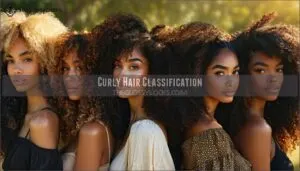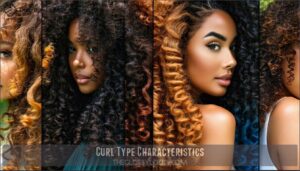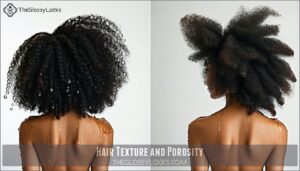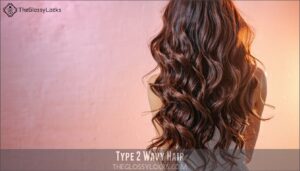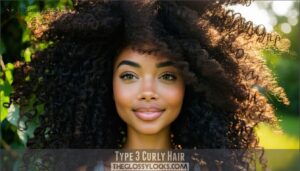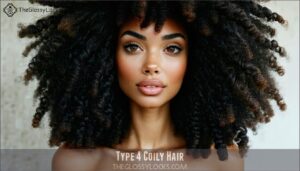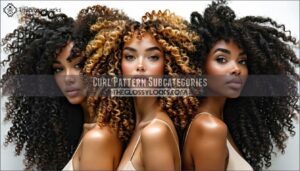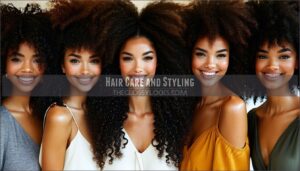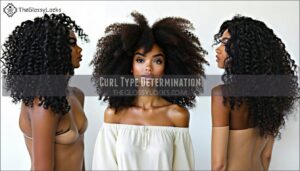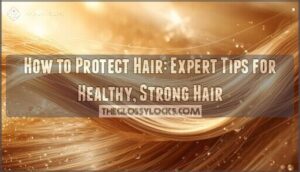This site is supported by our readers. We may earn a commission, at no cost to you, if you purchase through links.
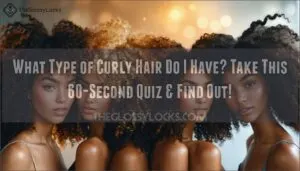 Your curly hair type depends on the shape and texture of your strands, which can range from loose waves to tight curls.
Your curly hair type depends on the shape and texture of your strands, which can range from loose waves to tight curls.
Most people use the Andre Walker Hair Typing System, which categorizes curls into three main types: wavy (Type 2), curly (Type 3), and coily (Type 4).
Look at your curl pattern when your hair is clean and air-dried—if it forms S-shaped waves, you’re Type 2.
Springy, defined curls point to Type 3, while tight zigzag curls suggest Type 4.
Don’t forget, porosity and texture also play a big role!
Curious about mixed patterns? You’re not alone—it’s perfectly normal.
Table Of Contents
Key Takeaways
- Check your clean, air-dried hair for S-shaped waves, ringlets, or zig-zag patterns to figure out if you’re Type 2, 3, or 4.
- Understand that most people have mixed curl patterns, so focus on your dominant type and use products tailored to it.
- Knowing your hair’s porosity and density is crucial for choosing the right products and keeping curls healthy and moisturized.
- Your scalp health, weather, and even hormones can affect your curl definition, so maintain balance and adapt your routine as needed.
Curly Hair Classification
You’ll need to understand your curl classification to choose the right products and styling techniques for your hair.
From the Andre Walker system to LOIS and NaturallyCurly methods, these typing systems can help you finally solve that "what-am-I-doing-with-this-mane" mystery that happens every morning in front of the mirror.
Andre Walker Hair Typing System
Celebrity hairstylist Andre Walker created the most widely-used curl pattern chart in the 1990s while working with Oprah.
Andre Walker revolutionized curly hair care with his iconic curl pattern chart, transforming how we understand textures and embrace natural beauty.
His Walker System Overview classifies hair into four types: straight (1), wavy (2), curly (3), and coily (4), with A-C subtypes for each.
Despite some cultural impact and modern adaptations, critics note system limitations regarding hair density variations and implicit hierarchy favoring looser curls.
Take our hair type quiz to identify your curl pattern!
LOIS Hair Typing System
Unlike number-based systems, the LOIS Hair Typing System breaks down your curls using letters instead of numbers.
Created with Black hair in mind, it classifies your strands by pattern (L, O, I, S), strand size, and texture types (thready, wiry, cottony, spongy, silky).
This system comparison reveals a more thorough approach, acknowledging that most people have multiple hair patterns on their head rather than just one hair type.
NaturallyCurly Hair Typing System
The NaturallyCurly Hair Typing System offers a more nuanced evolution of Andre Walker’s original classification.
It focuses specifically on wavy (2A-2C), curly (3A-3C), and coily (4A-4C) hair types.
Each subcategory indicates the diameter of your curl pattern—"A" being widest and "C" being tightest.
One can also use Fia’s hair typing to classify hair using distinctive markers for curl definition and strand nuances.
Despite some system limitations, its community impact has been revolutionary, helping you identify your curl pattern with greater precision than ever before.
Fia’s Hair Typing System
Evolution sparked Fia’s Hair Typing System, combining Andre Walker and LOIS approaches for a thorough curl type assessment.
This upgraded system evaluates your hair using three key metrics:
- Curl definition that ranges from straight Type 1 to very curly Type 4
- Strand appearance that considers multiple sizes within the same head of hair
- Volume assessment that acknowledges you might’ve several curl patterns simultaneously
This system comparison avoids racist ideologies while providing practical hair classification guidance, ensuring a thorough and unbiased assessment of one’s curl type.
What Type Curly Hair
You’ve got those beautiful curls, but you’re not quite sure what type you’re working with, and that’s totally okay!
Understanding your specific curl pattern is the key to finding the right products and styling techniques that’ll make your natural texture shine at its absolute best.
Identifying Curl Pattern
Now that you’re familiar with classification systems, let’s figure out your unique curl pattern. Look at your hair when it’s both wet and dry—the difference can be surprising!
Your curl pattern directly relates to your follicle shape. Remove product buildup before evaluating and consider your shrinkage factor.
Most heads have pattern variations, with different types of curls in different areas. A curl pattern chart can help you compare your hair curl type visually.
The shape of your follicles, influenced by embryonic genes, plays a vital role in determining your curl type.
Curl Type Characteristics
Each curly hair type has its quirks.
Wavy hair (Type 2) forms soft S-shaped patterns, while curly hair (Type 3) creates springy loops from loose to tight.
Coily hair (Type 4) showcases tight zig-zags or coils.
Understanding your hair curl type enhances styling and care routines, helping you embrace your natural curl definition with confidence!
Hair Texture and Porosity
Understanding hair texture and porosity is key to healthy curls.
Fine Hair feels delicate, while texture varies from silky to rough.
Low Porosity repels moisture, leading to product buildup, while High Density means more strands.
Damage assessment reveals raised cuticles affecting hydration.
Want clarity? Take a hair type quiz to determine your hair texture and porosity!
- Fine Hair: Soft, delicate strands.
- Low Porosity: Water beads on the surface.
- High Density: Fuller volume, heavier feel.
- Product Buildup: Common with improper care.
- Damage Assessment: Raised cuticles lead to frizz.
Curl Pattern Basics
Understanding your curl pattern is the first step to revealing your hair’s potential and choosing the right care routine.
Understanding your curl pattern unlocks the secret to showcasing your natural beauty and finding the perfect care routine for your curls!
From loose waves to tight coils, your curls have a unique personality that deserves the spotlight!
Type 2 Wavy Hair
Type 2 wavy hair has soft, S-shaped patterns that sit between straight and curly.
It’s prone to frizz, but with the right styling techniques, it shines effortlessly.
Focus on lightweight products for volume boost and frizz control.
Scrunch while damp to enhance waves, and air-dry or diffuse gently.
It’s all about playful bounce and texture!
Type 3 Curly Hair
Type 3 hair, with its springy curls, brings volume and personality.
Defining Type 3 curls means knowing 3A shapes are looser than 3B’s tighter ringlets, while 3C challenges include tangles and product buildup.
Maintaining definition requires hydration, lightweight styling creams, and careful detangling.
Embrace your curl type—these bouncy spirals make a bold, lively statement with just the right care.
Type 4 Coily Hair
Type 4 hair, also called coily or kinky, features tight spirals or zig-zag patterns.
It’s beautiful but easily dehydrated, making moisture retention a must. High shrinkage is a common characteristic of this hair type.
Try:
- Protective Styling (braids, twists).
- Deep Conditioning weekly.
- Silk Pillowcases to lock in hydration.
- Tension Straightening for safe lengthening.
- Use rich creams designed for type 4 hair.
Curl Pattern Subcategories
Within curly hair types, subcategories A, B, and C focus on curl diameter—wider curls fall into A, medium curls land in B, and the smallest curls define C.
For instance, identifying curl patterns like 3A’s loose spirals or 4C’s tiny coils helps narrow choices in this curly hair guide.
Specifics make your curly hair classification easier and more precise, and understanding these details is key to finding the right products and care for your curly hair.
Hair Care and Styling
In the context of caring for your curls, matching the right products and techniques to your hair type is a game-changer.
Whether you’re taming frizz, defining curls, or keeping them hydrated, the right routine makes all the difference.
Type 2 Care and Styling
If your hair fits the wavy hair type, lightweight wavy hair products like mousse or gel are your best friends for enhancing waves without weighing them down.
Try scrunching methods or air-drying tips for extra definition.
Diffusing techniques work wonders for volume and frizz control. Many users find wavy hair mousse enhances their waves.
Just avoid creamy textures that could flatten your gorgeous type 2 waves!
Type 3 Care and Styling
For Type 3 curls, moisture retention is key. Use lightweight products for soft hold, focusing on curl definition.
Detangle gently with a wide-tooth comb or wet fingers. Styling products like creams can tame frizz while enhancing shape.
Regular trimming techniques prevent split ends. Explore options for specialized type products to enhance your routine.
Embrace your curly hair characteristics with scrunching or diffusing for texture and bounce!
Type 4 Care and Styling
Caring for Type 4 hair—whether 4A, 4B, or 4C—means embracing protective styling and prioritizing moisture retention.
Deep conditioning is your best friend for kinky, coily hair types, while silk pillowcases prevent dryness.
Use tension methods to reduce breakage and keep styles low-maintenance.
To maintain healthy and hydrated Type 4 hair, consider using specialized hair products for moisture retention, and remember that a little love can keep your curls thriving—hydrated, healthy, and fabulously defined with proper care!
Curl Care Routine
A solid curl care routine can change everything.
Focus on hydration and simplicity:
- Moisturize with product layering for long-lasting definition.
- Use protective styling or silk pillowcases for a smart night routine.
- Prioritize scalp health by clarifying monthly.
- Revitalizing curls daily with water and a lightweight mist keeps them lively.
Take a hair type quiz to truly determine your needs and find the best approach for simple curl care.
Curl Type Determination
Figuring out your curl type might seem tricky, but it’s easier than you think with a little observation.
From your curl shape to your hair’s texture, understanding these details can help you discover the secrets to the perfect hair care routine.
Hair Follicle Science
Shaped like tiny architects, your hair follicles decide everything—curl formation, thickness, and even cysteine bonds for your spirals.
Oval follicles? Hello, curls! Round? Straight as a pin!
Mixed patterns from varied follicle shapes make styling unpredictable but charming.
| Feature | Detail | Impact on Hair |
|---|---|---|
| Follicle Shape | Oval, Round | Curl or Straight |
| Cysteine Bonds | Curved Follicles Compact | Tighter Curls |
| Hair Thickness | Larger Follicle | Thicker Strands |
| Hair Bulb | Produces Growth Cells | Hair Length |
| Hair Root | Anchors Strand | Scalp Health |
Curl Formation and Hair Fiber
Understanding how curls form starts with your follicle shape. Oval follicles create waves or curls, while round ones produce straight hair.
Hair fiber properties and the way cysteine bonds cluster also play a big role in curl genetics. Genetic influences also substantially determine hair shape.
Want to visualize it?
- Flat follicles = tighter curls
- Curved follicles = looser waves
- Compact cysteine bonds = smaller curls
Mixed Curl Patterns
Curl patterns on your head can vary, creating unique combinations.
To manage multi-textured care, use sectioning strategies and blending products that cater to different curl types.
Identifying your dominant pattern helps determine hair type and plan routines.
Embrace these curly hair characteristics, as curl classification celebrates diversity.
Remember, curl pattern combinations add personality, not problems!
Determining Curl Type and Texture
Figuring out your curl type takes more than a glance; you’ll need wet hair, patience, and a touch of curiosity.
Use the Wet Hair Test to see your natural pattern. Follicle shape matters—oval ones mean tighter curls.
Don’t skip hair texture analysis for Density and Porosity. These details guide product application and uncover curly hair characteristics!
Frequently Asked Questions (FAQs)
What are 2A, 2B, 2C, 3a, 3b curls?
Curly hair types like 2A, 2B, 2C have loose, defined waves, while 3A, 3B bring springy, tighter curls.
Picture ocean waves versus ringlets.
Each type craves care—lighter products for waves, hydration for curls.
Are my curls 2B or 2C?
Your curls might be 2B if they’re loose waves with some definition but tend to frizz.
If they’ve a stronger “S” shape, more volume, and less frizz, they’re likely 2C.
Am I 3C or 4A?
Your curls are like a spiral dance—determining 3C or 4A depends on their size and shape.
If your coils resemble tight corkscrews, you’re 3C.
Smaller, more springy curls leaning zig-zag? That’s 4A!
How does scalp health affect curl pattern?
A healthy scalp is like fertile soil for lush hair.
Poor scalp health can disrupt your curl pattern, causing uneven texture, dryness, or frizz.
Keep it clean, moisturized, and balanced for bouncy, defined curls!
Can diet or hydration influence curl definition?
Your curls thrive on good nutrition and hydration!
Drinking water keeps strands plump, while eating nutrient-rich foods, like salmon or avocados, boosts natural oils and elasticity.
Think of it as feeding your curls from within!
Does weather impact how curls behave daily?
Humidity can boost curl definition or create frizz—it’s like your curls have their own weather app.
Dry air often flattens curls, while rainy days might make them shrink.
Weather’s basically your curls’ mood ring!
What role do hormones play in curl changes?
Your hormones can make your curls shift over time.
Pregnancy, menopause, or thyroid changes might loosen or tighten textures.
Think of it as your hair’s way of reflecting life’s ups and downs—literally!
Are there vitamins that enhance curly hair growth?
Yes, vitamins can help!
Biotin, vitamin D, and omega-3 fatty acids support hair growth and strength.
Pair them with a balanced diet—because no vitamin beats the magic of eating well and staying hydrated!
Conclusion
Understanding your curly hair is like deciphering a secret code—it helps you care for it the right way.
Whether you’ve got loose waves, springy curls, or tight coils, knowing your pattern and texture is key to getting the results you want.
Don’t stress over mixed patterns; they’re completely normal. Take a moment to identify what type of curly hair you have and try out routines that suit your strands.
Your curls will thank you with bounce and shine!

